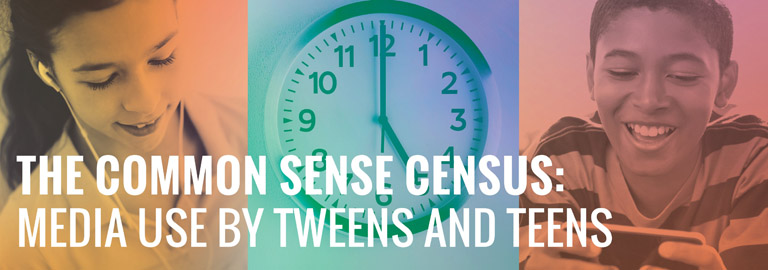#8to18 Yr Olds Use Media Constantly: Why You Shouldn't Freak Out abt the @CommonSenseEdu @CommonSenseMedia Study

You’ve probably seen the headlines following the Common Sense Census: Media Use by Tweens and Teens. Adults seemed shocked that teens spend 9 hours and tweens 6 hours a day with media. Knee-jerk reactions include a call for a shutdown switch for devices after a set time. No media in bedrooms. No technology while doing homework.

Now take a breath.
Putting the numbers in context
Let’s put this study into context. 9 hours includes each hour spent using media, even when doing other things. If you listen to Pandora while you go out for a jog, that counts. Have music on while doing your homework? That counts. Listening to a podcast while cleaning your room? That counts too.
Choosing our own background noise while engaging in useful activities, is not a bad thing and that is one way some teens are spending their media time.
Multitasking
"Teenagers think that multitasking during homework doesn't affect their ability to learn and ... we know it does," said James Steyer, chief executive officer and founder of Common Sense Media, citing studies such as one at Stanford, which found dramatic differences in cognitive control and the ability to process information between heavy media multitaskers and light media multitaskers. "It's completely obvious that you can't multitask and be as effective and competent."
Tools and ideas to transform education. Sign up below.
But is it?
Once you scratch beneath the headlines, you find the studies are flawed. They measure multitasking by creating an artificial environment where the tasking is done “to” rather than “by” the subjects in the study. Educator, Ira Socol elaborates on their fatal research mistakes here among other things pointing out the absurdity of measuring nonsense tasks.
Don Tapscott author of the book Growing Up Digital and its sequel Grown Up Digital, puts it this way: “Rather than creating dysfunctional brains that can't focus, the evidence is just as strong that experience being "bathed in bits" is pushing the human brain beyond conventional capacity limitations. So-called multitasking may in fact result from better switching abilities and better active working memory. Young people are likely developing brains that are more appropriate for our fast paced, complex world.”
Restrictions are ineffective
In all the hysteria there’s a call for a quick-fix. Parents can set limits or use controls that just shut media off and save the day. The idea is a bad one for many reasons.
First, it places media as a problem rather than identifying if a problem actually exists. We need to stop targeting media as the problem and start getting to the heart of the issue...if there really is one.
Think about it. Media has become our tool to access the world in new ways. We might be playing a game on Nintendo Wii, Sony Playstation, and Microsoft Xbox Connect that helps us get more fit. This is a great choice when it’s dark outside and/or streets are not safe options. Or, maybe young people are learning to build playing Minecraft or learning world history by being a part of it with games like Rise of Nations.
Maybe that young person who seems obsessed with Instagram has actually found just the right platform to share something about which they are passionate and develop a global network. That’s exactly what teenager Alex Laubscher uses his Instagram account for.
Rather than judging students using Snapchat (and in some cases banning it), find out what they’re doing. Perhaps students are using Snapchat in powerful ways to communicate and share stories. Perhaps the media kids love can be integrated into learning.
The myth of addiction
“But today’s youth are addicted. They use media all day. It’s a crisis.”
No. It’s not. When media and screens are what we use to do almost all the things we do, of course we use it a lot. We use it to read and write more than ever before. We use it to communicate to others across the globe. We use it to learn about places we may never have a chance to visit. We use it to calculate directions, convert measurements.
Our technology has become our parents’ books, pens, papers, telephone, calculator, ruler, and more. However, you never hear concerns about book, pen, or calculator restrictions or addictions.
Are some young people suffering from some sort of addiction to tech? Absolutely...but it’s not what happens to most kids using media in typical ways. The studies about media use and addiction are generally focused on troubled boys addicted to violent video games or pornography.
The point is that simply because we are using media, does not mean there is an addiction problem. A focus on the media rather than the person can lead one to a solution of the wrong problem, and a continued misunderstanding of what the problem really is. This could lead to a rift between parent or teacher and child that will only get deeper as long as adults continue to focus on media, instead of individuals.
What adults should be doing
For many adults, this is a black and white issue: tech, bad. No tech, good. Tech is not good or bad; it is simply here, it is going to stay, and our kids love it. Teachers and parents should resist the urge to reduce this issue to what is most easily understandable.
Instead of restrictions and controls, concerned adults should help young people determine if what they are doing interferes with ordinary life responsibilities, such as, relationships, health, work (if applicable), or “meaningful” learning. If it does, there is still more work to do before assuming you need to limit media or fix the young person. Perhaps schoolwork is suffering because the student finds it boring and irrelevant, and they may be right. Perhaps family relationships are suffering because of an unwillingness on the part of adult to communicate in the online worlds of the young people in their lives.
Ultimately, it boils down to this: if we want to ensure our children are healthy, happy, and fulfilled, restricting media isn’t the solution...it’s a quick fix without understanding the problem. Instead, engage in non-judgmental dialogue, active listening, conversations about values, and putting yourself in the shoes of the tweens and teens in your life. This, not restricting media, is the key to maintaining positive relationships and developing happy and fulfilled #8to18 year olds.
Lisa Nielsen writes for and speaks to audiences across the globe about learning innovatively and is frequently covered by local and national media for her views on “Passion (not data) Driven Learning,” "Thinking Outside the Ban" to harness the power of technology for learning, and using the power of social media to provide a voice to educators and students. Ms. Nielsen has worked for more than a decade in various capacities to support learning in real and innovative ways that will prepare students for success. In addition to her award-winning blog, The Innovative Educator, Ms. Nielsen’s writing is featured in places such as Huffington Post, Tech & Learning, ISTE Connects, ASCD Wholechild, MindShift, Leading & Learning, The Unplugged Mom, and is the author the book Teaching Generation Text.
Lisa Nielsen (@InnovativeEdu) has worked as a public-school educator and administrator since 1997. She is a prolific writer best known for her award-winning blog, The Innovative Educator. Nielsen is the author of several books and her writing has been featured in media outlets such as The New York Times, The Wall Street Journal, and Tech & Learning.
Disclaimer: The information shared here is strictly that of the author and does not reflect the opinions or endorsement of her employer.
